Rick Wayne's Blog, page 19
June 19, 2020
June 17, 2020
(Fiction) The Bleeder
The bus pulled onto the shoulder to report the bleeder on the side of the highway. At some point, a car had clipped the man’s leg, which was bent awkwardly to one side. His hands were frozen into fists and his feet had gone completely limp. The tips of his loafers wobbled over the ice and gravel like a record needle as he dragged himself forward on his elbows, one after the other, as if fleeing for his life in slow motion. He felt neither cold nor pain, and his frosted eyes remained fixed on some distant salvation even as the gargantuan bus pulled to a stop immediately behind him.
“I dunno why we gotta wait for this,” a white-bearded man in overalls declared loudly from the back.
“It’s the law,” someone whispered.
Nio heard the bus conductor speak softly into the radio as passengers leaned into the aisle to peer out the high windshield. In the distance, the overcast sky was beginning to clear. A pair of teenagers, too young to remember the outbreak, snapped pictures of the awkward, broken man now illuminated in the alternating flashes of the bus’s hazard lights. On the freeway, the tires of a passing car sprayed icy slush across the shoulder. It struck the bus’s undercarriage in clumps and nearly doused the disheveled man, who paid it no mind. He simply lurched forward again, dragging himself limply along.
“That poor man,” a woman near the front told her companion.
“He shoulda lined up like everyone else,” the grisly bearded man declared. He removed his red NRA cap and held it aloft like a free pass. “Let’s get goin’ already. I gotta take a piss.”
There was a click of static as the conductor announced over the speakers they would be waiting approximately ten minutes for the highway patrol to arrive. The grisly man threw up his arms.
After a second passing car honked its horn repeatedly, the baby in the seat across from Nio, one aisle ahead, started to cry, softly at first, then much louder.
“Great . . .” The bearded man shook his head.
The infant’s mother rocked her child gently and tried to quiet him, but he was hungry or cold or had simply had enough of the bus and was letting the whole world know. Several passengers shuffled in annoyance.
“Shhh . . .” the young mother intoned. Her round, smooth face was darkly complected and bore equal measures of patience and fear.
Nio leaned forward across the aisle with one hand extended. “He’s beautiful. May I?”
The young woman nodded, happy to have an ally, but was awkwardly surprised to see Nio press a hand to the child’s forehead, as if feeling for a fever, rather than caress his scalp as she had expected. Almost instantly, the child quieted. After another moment of contact, his eyes fluttered and he began sucking an invisible pacifier. Nio heard quiet exhales of relief. As she leaned back into her seat, more than one person turned from the front to peer at her through the gaps between the seats. She certainly stood out, with a shaved head and heavy loops in her ears. She turned up her puffy jacket’s nose-high collar and crossed her arms.
Colored lights flashed across the ceiling as a patrol car pulled around the bus and parked at an angle, partially blocking the road but also shielding the bleeder from oncoming traffic. The trooper got out and walked around to the door of the bus, which opened with a hiss. Cold air whipped up the aisle and around Nio’s ankles. After trading a few words with the conductor, the trooper thanked him and waved him on.
“Finally . . .” the grisly man said. “My teeth are frickin’ floatin’ back here.”
The bus tires carved valleys in the roadside slush as the big vehicle pulled onto the highway and began accelerating smoothly. Several passengers clapped.
Nio watched from the half-frosted window as the bleak landscape passed. Tufts of brown grass poked up through a fondant of white. Low hills were cut into barbed-wire squares. She had traveled nearly 300 miles across the high plains of North America. Somewhere ahead, a woman she had never met was dying. She took out the unopened letter from her coat pocket and stared at it.
Pasture and fields gradually gave way to repair shops, fast food chains, and half-derelict shopping centers, but it wasn’t until they passed a boarded Dollar-Savr that Nio noticed the damage. It looked like a tornado had hopped across the little town on a pogo stick. A dead tree had left a three-meter hole in the earth after it was uprooted and dropped onto a snow-topped house. A plump Buddha had fallen from its perch over a Chinese buffet and now golden-mooned passersby from the parking lot. Ice-covered cars were scattered about the ditches and parking lots like a giant child’s abandoned toys.
The bus pulled slowly past the cluster of low buildings at the center of town and stopped in a parking rectangle near a 24-hour diner. The engine rumbled gently as the conductor announced a thirty-minute break for those continuing to Jamestown. Nio lifted the strap of her rolled bag over her head and stepped down to a sidewalk pockmarked in frozen footprints, like the fossil of prehistoric riverbed. Her breath billowed over her puffy coat’s high collar, and she huddled into it for warmth. It was the fourth day of record-setting April cold. It was supposed to last another four. The few townspeople that had ventured outside looked like they were preparing for an inland hurricane. Storefront windows were being taped in large Xs. The sidewalk display in front of a nail salon was being chipped from the ice so it could be brought inside. A handwritten note on the door of an old-style pharmacy announced that it was closing early for Moving Day. A similar announcement was posted to the door of the diner, next to the one that declared it was for Red Staters Only.
selection from my novel-in-progress, tentatively called Science Crimes Division
cover image by Simon Stalenhag, used without permission
June 15, 2020
(Art) The Human Mysteries of Boris Pelcer
[image error]
It’s hard to imagine another artist capturing the dark contradictions of the individual any better than Boris Pelcer. His wounded, brooding figures are as much in pain as they are the cause of it. If, as the saying goes, the obstacle is the path, then the path is ourselves.
Find more by the artist and purchase prints on his website.
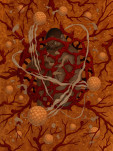
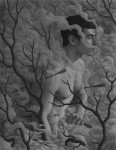

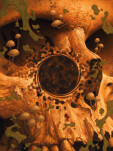





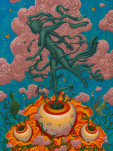

June 14, 2020
(Curiosity) Past Participles: History & Secession
People read passages from The Federalist papers in school, or an ancient treatise on Stoicism or whatever, and it informs their sense of how things were in the past, forgetting (or worse, never realizing) that the works selected for primary education represent the advances of the age, usually by its greatest thinkers, and as such are closer to a modern university symposium or think tank white paper than everyday discourse.
Before the era of widespread literacy, little is recorded of the average person’s views. The glimpses we get are not appealing. During the American revolution, for example, there were a slew of pamphlets distributed. The reason your history teacher made you read The Federalist versus any of those others is because it was actually comprehensible. In the years leading up to 1776, conspiracy theories (analogous to “Obamagate” or Russian collusion) abounded on the part of both loyalists and the independence movement. Some fraction of it was probably based in fact, such as the conspiracy to kill General Washington.
This is extremely important because our impression of the past — including from movies, which are almost always fake — directly informs our sense of whether things are better or worse now than they were before, or whether certain points of view are reasonable or accurate. It even bounds the range of possible solutions to contemporary problems that people will consider, all based on what are probably wholly misleading representations of what ordinary life, which is what we experience, was actually like back then.
For example, before everyone runs around all hoary and hoarse about recent events, be aware the following is not even a complete list:
The State of Franklin (1784-1788)
For a few years, counties now in eastern Tennessee but then part of North Carolina created their own state, ostensibly named for Benjamin Franklin (who declined to assist them). It ended in a fight that killed three men and wounded many others.
The Great Republic of Rough and Ready (1850)
Formed during the California Gold Rush by ex-military, the town was named for Gen. Zachary Taylor (“Old Rough and Ready”) who had been recently elected president. The town seceded, forming its own republic, to avoid paying mining tax. It rejoined the union with a whimper three months later.
The Mormon Kingdom of Beaver Island (1856)
In 1848, the Mormon preacher james Strang fled with his 2,600 followers to tiny Beaver Island, near Mackinac, Lake Michigan. He later declared himself king of his church. Since the locals were outnumbered, King Strang was the de facto ruler of the island. Skirmishes were common. King Strang even fired a canon at local fishermen. The US sent a gunboat but preferred to resolve the situation peacefully. After Strang introduced a rule that required husbands to be beaten if their wives refused to abide by his dress code, he was killed by his own men. The island was retaken, not by the US military but by an angry mob from neighboring communities.
The State of Absaroka (1937)
Formed from parts of northern Wyoming, southern Montana, and western South Dakota, the state of Absaroka was proposed by anti-New Deal conservatives who were angry at the government in Cheyenne. The street commissioner of Sheridan declared himself governor. License plates were made and a “Miss Absaroka 1939” pageant was held, but nothing ever came of the movement.
The McDonald Territory (1961)
After the Missouri State Highway Commission left the tiny town of Noel off its “Family Vacationland” map, officials in McDonald County announced their plans to secede and form the 51st state, along with Benton County, Arkansas (home of Wal-mart) and Delaware County, Oklahoma. The nascent territory formed a government, complete with separate postal service that printed its own stamps. The local militia stopped visitors at the border and issued tourist visas.
The Conch Republic (1982)
Angered by a US Customs and Border Patrol roadblock on US Highway 1, the Mayor and City Council of Key West, Florida declared the island independent in 1982, entirely for publicity. They argued that if the US government was going to treat them as a foreign country, they may as well become one. The island was declared the Conch Republic and a flag was made.
And that’s not even mentioning the second-largest secession, the Confederate States of America, or the first, The United States of America, which unilaterally seceded from the Kingdom of Great Britain.
This is what we do, people. Relax.
cover image by a user on Reddit.
(Art) The Dream Wraiths of Maria Zolotukhina
[image error]
The works of Russian artist Maria Zolotukhina hover at the twilight of consciousness. Her darkly dramatic paintings depict unsettling dreamlike scenes with classical motifs — portraiture, still life, landscape, religious icon — and are full of portent without dipping into horror.
Find more by the artist on her ArtStation page.





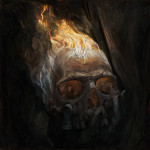














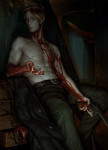
June 12, 2020
(Curiosity) Past Participles: History & Secession
People read passages from the Federalist papers in school, or an ancient treatise on Stoicism or whatever, and it informs their sense of how things were in the past, forgetting (or worse, never realizing) that the works selected for primary education represent the advances of the age, usually by its greatest thinkers, and as such are closer to a modern university symposium or think tank white paper than everyday discourse.
Before the era of widespread literacy, little is recorded of the average person’s views. The glimpses we get are not appealing. During the American revolution, for example, there were a slew of pamphlets distributed. The reason your history teacher made you read Federalist versus any of those others is because it was actually comprehensible. In the years leading up to 1776, conspiracy theories (analogous to “Obamagate” or Russian collusion) abounded on the part of both loyalists and the independence movement. Some fraction of it was probably based in fact, such as the conspiracy to kill General Washington.
This is extremely important because our impression of the past — including from movies, which are almost always fake — directly informs our sense of whether things are better or worse now than they were before, or whether certain points of view are reasonable or accurate. It even bounds the range of possible solutions to contemporary problems that people will consider, all based on what are probably wholly misleading representations of what ordinary life, which is what we experience, was actually like back then.
For example, before everyone runs around all hoary and hoarse about recent events, be aware the following is not even a complete list:
The State of Franklin (1784-1788)
For a few years, counties now in eastern Tennessee but then part of North Carolina created their own state, ostensibly named for Benjamin Franklin (who declined to assist them). It ended in a fight that killed three men and wounded many others.
The Great Republic of Rough and Ready (1850)
Formed during the California Gold Rush by ex-military, the town was named for Gen. Zachary Taylor (“Old Rough and Ready”) who had been recently elected president. The town seceded, forming its own republic, to avoid paying mining tax. It rejoined the union with a whimper three months later.
The Mormon Kingdom of Beaver Island (1856)
In 1848, the Mormon preacher james Strang fled with his 2,600 followers to tiny Beaver Island, near Mackinac, Lake Michigan. He later declared himself king of his church. Since the locals were outnumbered, King Strang was the de facto ruler of the island. Skirmishes were common. King Strang even fired a canon at local fishermen. The US sent a gunboat but preferred to resolve the situation peacefully. After Strang introduced a rule that required husbands to be beaten if their wives refused to abide by his dress code, he was killed by his own men. The island was retaken, not by the US military but by an angry mob from neighboring communities.
The State of Absaroka (1937)
Formed from parts of northern Wyoming, southern Montana, and western South Dakota, the state of Absaroka was proposed by anti-New Deal conservatives who were angry at the government in Cheyenne. The street commissioner of Sheridan declared himself governor. License plates were made and a “Miss Absaroka 1939” pageant was held, but nothing ever came of the movement.
The McDonald Territory (1961)
After the Missouri State Highway Commission left the tiny town of Noel off its “Family Vacationland” map, officials in McDonald County announced their plans to secede and form the 51st state, along with Benton County, Arkansas (home of Wal-mart) and Delaware County, Oklahoma. The nascent territory formed a government, complete with separate postal service that printed its own stamps. The local militia stopped visitors at the border and issued tourist visas.
The Conch Republic (1982)
Angered by a US Customs and Border Patrol roadblock on US Highway 1, the Mayor and City Council of Key West, Florida declared the island independent in 1982, entirely for publicity. They argued that if the US government was going to treat them as a foreign country, they may as well become one. The island was declared the Conch Republic and a flag was made.
And that’s not even mentioning the second-largest secession, the Confederate States of America, or the first, The United States of America, which unilaterally seceded from the Kingdom of Great Britain, or the sovereign citizens’ movement or any number of active secessionist movements.
This is what we do, people. Relax.
cover image by a user on Reddit.
(Art) The Dream Wraiths of Maria Zolotukhina
[image error]
The works of Russian artist Maria Zolotukhina hover at the twilight of consciousness. Her darkly dramatic paintings depict unsettling dreamlike scenes with classical motifs — portraiture, still life, landscape, religious icon — and are full of portent without dipping into horror.
Find more by the artist on her ArtStation page.





















June 11, 2020
(Fiction) Love Call
The video conference device droned.
“Show time.”
Quinn hit the button and the screen split into six boxes. The first was the conference room at the FBI office in New York. Seven agents, including Special Agent Erving, sat around a table. A pair of agents in Minneapolis sat next to each other awkwardly in the next feed. The third was a lone agent in a sparse room. The label said “Dallas.” The fourth was Nio’s motel room. The fifth was a conference room at Quantico labeled “Behavioral Analysis.” The last was Dr. Chang, who sat at a large mahogany desk. Behind him was a cabinet full of hardbound legal texts.
“Let’s get started,” Erving said.
“You’re audio’s a bit weak, sir,” Quinn noted.
“Roger that.”
The agents in the room moved the microphone closer.
“How was your family leave?” Erving asked Quinn.
“It was good, sir. Thank you.”
“You sure you don’t need more time?”
“If it’s all the same to you, sir, let’s catch this guy.”
“Ms. Tesla,” Erving said, “I trust you are relaxed and ready to go.”
“As much as I’ll ever be.”
“I’m sure all of you know Dr. Hamilton Chang, the president’s science adviser. He’s asked to be updated on this case. He’s joining from his office in DC. I suppose we should start with the bad news. We have another victim.”
Nio shot up. “What?”
A female agent sitting next to Erving took over the briefing. “82-year-old Harold Sands and his wife were found by Fort Worth PD this morning.”
She lifted a small remote from the table and pressed it. The screen changed to a static picture of an elderly white man with sparse but wild white hair. Bloody bandages were taped over his forehead. His eyes were crazy.
“Mr. Sands apparently removed part of his own forebrain and . . . fed it to his wife of 37 years, who is suffering from advanced Alzheimer’s.”
“Jesus . . .” someone said.
“It gets worse,” Erving warned.
Nio and Quinn looked for each other’s reaction as the screen changed.
“This is the crime scene as it was found this morning.”
An elderly woman in a nightgown was chained to an old bed. Her lips were stained red-brown and frozen in a wail. A pair of symmetrical burn marks adorned both sides of her forehead. There was a cluster of ruptured cysts on her neck. Nio leaned forward when she saw them.
“Mr. Sands was led to believe that the brain tissue, in conjunction with transcranial stimulation, would abate his wife’s symptoms. Or so he informed police when they took him into custody.”
“Agent Jindal,” Erving said to the microphone, “have you had a chance to interview the suspect?”
The video changed to the officer in Dallas. “Not yet, sir. He’s still in surgery.”
“What’s the word?”
“Touch and go. Even if he survives, he has virtually no chance of a normal life. The part of the brain he removed is the . . .” Agent Jindal started skimming through his notes.
Nio said “ventral prefrontal cortex” at the same time Dr. Chang said “orbitofrontal cortex.”
Everyone paused.
“Yeah,” Agent Jindal confirmed. “That. Docs said it’s involved in decision-making.”
Dr. Chang was reviewing papers while he listened. He looked up. “Don’t wait for me, Ms. Tesla. Please.”
“It’s the part of the brain involved in response inhibition,” she explained. “Damaging or removing it would make him less likely to stop what he was doing. It’s also one of the few parts of the brain you could remove by yourself with a mirror.”
“So, with that part missing or damaged, Mr. Sands would be more likely to stick with the plan even if his wife resisted,” Erving clarified.
“Basically. Her reaction, no matter how extreme, would be much less likely to deter him. It was a way of making sure he’d go through with it.”
“Where did the burns come from?” one of the agents in Minneapolis asked.
“That’s the transcranial stimulation,” Agent Jindal said. “Someone sent him an antique electroshock device. Damn thing is made of brass.”
“That’s good,” someone off-camera suggested. “Antique like that might be traceable.”
“Please tell me you found the box it came in,” Erving added.
“Local PD are going through his trash. There’s a lot of it, sir. The couple were basically hoarders. House is something else. And—” He stopped.
There was an awkward pause. Erving was about to speak when Nio blurted “What are you not telling me?”
There was another pause. Dr. Chang looked up from his papers, suddenly very interested.
Special Agent Erving leaned over the mic. “Excuse me?”
“He wouldn’t pick a mentally ill elderly couple. It’s no challenge for him. He targets fully competent people, smart ones even. Tricking them into hurting each other is how he proves he’s better than everyone. A couple of elderly hoarders would be no challenge.”
“Are you saying this isn’t our guy?”
“No, it’s definitely him. Everything fits. Those cysts are identical. Which means there’s some reason he broke the pattern. Everyone on this call has ties to the bureau. Except me. So what is it I’m not supposed to hear?”
Erving sat back, clearly frustrated. He sighed. “Tell her.”
The agent to his right, a stocky, muscular man in a gray suit, took the remote control and pressed it.
“We pulled the household internet history. These videos had been watched repeatedly over the last several days.”
The screen switched to footage of Dr. Quest, a charismatic TV physician, on the set of his show. He was describing, with a smile on his face, how to use the electroshock machine.
“Deep fake,” Nio said.
“Yes,” the agent answered. “We think Mr. Sands thought he was communicating with Dr. Q. This is the part.” The agent turned the volume up.
This particular process was developed by Nikola Tesla himself and stimulates immediate regeneration of nerve tissue. The reason no one knows about it is because Edison ’s men kept it secret and destroyed most of the working prototypes. Because your wife qualifies for our study, we’re providing this device free of—
The video stopped.
Quinn filled the silence. “He’s calling her out.”
“We believe so, yes.”
“There’s more,” Erving said. “The couple had a live-in caretaker. He is presently missing. Preliminary forensics indicates a struggle. Wherever he went, it wasn’t voluntarily.”
Dr. Chang removed his glasses and sat back. Everyone was looking at Nio, who sat on the edge of the bed staring at the floor, barely keeping it in.
“You have to let me find him,” she breathed.
“You are,” Special Agent Erving countered. “We’re all in agreement that your guidance here is invaluable. You’ve been chasing this guy longer than any of us. You’re on the team, Ms. Tesla.”
“You know what I mean,” she said. “Not from here. Not by teleconference.”
Erving didn’t answer.
Nio swallowed. “What else?” she asked without looking at the screen.
“He recorded the whole thing,” Agent Jindal said. “Through the home’s digital assistant, which was looping a song when local PD arrived.”
“So we’d be sure to find it,” Quinn said.
“Probably.”
“What song?” Nio asked.
“Umm . . .” Agent Jindal looked through his notes again. “It was an old song. Indian Love Call? By Slim Whitman.”
“Have you listened to the recording?” Quinn asked.
“I started. I—” Agent Jindal stopped. He cleared his throat. “I apologize, sir.” He was talking to Erving. “I’m having a little trouble making it to the end. The wife . . .” Agent Jindal’s voice broke.
Everyone was quiet.
“It’s just that his wife is begging for him to stop. It’s really hard to listen to, sir.”
“It’s all right,” Erving said. “I’d be worried about you if you wasn’t. Take your time, Prasad.”
Agent Jindal nodded. “Thank you, sir. I’ll upload it tonight with the rest.”
“I want to hear it,” Nio said.
“Nio . . .” Dr. Chang began. He sighed. He didn’t finish. He seemed to understand the futility.
“I’m not sure that’s a good idea,” Erving said.
“That poor man lobotomized himself and fed it to his wife before shocking her to death—as a message to me. I want to fucking hear it.”
Erving nodded to the screen.
“I’ll forward it to Agent Quinn,” Agent Jindal said.
“Thanks,” Quinn told him.
Nio stared at the floor.
“Quantico,” Erving said, “what the hell are we dealing with here?”
“Data suggests he’s probably male. 30s or 40s. It would be hard for someone younger to amass the knowledge he’s demonstrated. He’s very intelligent. Normal work wouldn’t be fulfilling for him. You’re probably looking for a scientist or other—”
Nio burst into a single laugh.
“You have something to add, Ms. Tesla?”
“He’s not an effing scientist. Not any more than I am.”
The team in Quantico clearly didn’t enjoy being contradicted. “Then what is he?” the lead agent asked.
“His need to be better didn’t come out of nowhere. He’s a narcissist and an overachiever. He’ll flaunt his superiority in all the socially acceptable ways: big house, fancy car. He has the resources to pull all this off, which suggests wealth, which ties to his narcissism. But setting this stuff up takes a lot of time. People like Maureen and Mr. Sands need to be groomed. I’d guess he’s an insomniac. If he shuts his eyes, he re-experiences whatever trauma drives him. Somebody told this guy over and over that he was inferior, the worst kind of human excrement. In his mind, the rest of society reinforced that, which is why he has no problems taking his frustrations out on strangers. He’ll have a high status job, one that rewards him financially for his intellectual gifts. He might be university trained but he’s not a bench scientist. He’s a senior executive at a tech company or maybe an investment bank.”
“Why a bank?” Quinn asked.
“Investment banks use cutting edge math. Both jobs skew heavy with psychopaths.”
“Quantico?” Erving asked.
“That’s not exactly our finding.” She paused. “But it’s close.”
“Share your report with the team.” Erving raised a finger in warning. “I expect everyone to read it. No exceptions. What about updates on the other victims?”
A woman in the New York conference room spoke. “Lab guys finally got back to us on the sequence recovered from Beckham Carter.”
“And?”
“They said it was a kind of cytoplasm, a protein matrix wrapped around sequences of mRNA. They think the proteins were just there to keep the RNA from degrading, but they have no idea what it’s for. It’s apparently very complex, thousands of times longer than normal.”
Quinn looked to Nio, but she only shook her head. His laptop dinged then and she got up without a word and took it outside.
June 10, 2020
(Art) The Eerie Animorphs of Olya Bossak
[image error]
Russian artist Olya Bossak, AKA Reycat, makes surreal and moving illustrations of cryptids, creatures, and animorphic humanoids, such as her “alternate angels,” which put the downward-facing wings under the arms. The change is subtle but effective, turning them from vessels of divine light to demigods with their own personality and agency.
Find more by the artist on her ArtStation page.

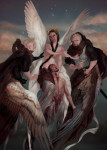














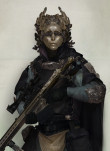



June 7, 2020
(Curiosity) The anti-Matrix
[image error]
When authors and pundits want to highlight some incongruity in the world, they’ll often say we’re in the Matrix, referring of course to the 1999 film. But we’re not in the Matrix. We’re in its complete antithesis: the anti-Matrix.
The world of the Matrix seemed real but was actually fake. It was rational and stable. It broke predictably, which was what gave the characters their fantastic powers. (Even The One was foretold.) Human beings generally wanted to stay inside. The heroes of the story had to trick them out. Machines controlled humans, but tech was liberating. We could learn Kung-fu with the press of a button. To fight the system, the rebels escaped the digital world to hide in the physical, which was blighted and unsalvageable. Freedom was bleak.
By contrast, the world of today seems fake but is actually real. It’s irrational and unstable. It breaks unpredictably and in increasingly spectacular ways. “Glitches” are not fixed. People generally want out. Corporations and governments have to trick us into playing along. Humans control machines that control humans, and tech is oppressive. We can be destroyed, personally and collectively, with the press of a button. To fight the system, rebels escape from the physical world to the digital, despite that the earth, however blighted, is still salvageable and freedom still possible.
Hopefully, the comparison is a little disconcerting.
To escape the anti-Matrix, we would have return to a minimum of collective sensemaking. I’m skeptical that’s possible absent a precipitating crisis. Among other things, it would require a large portion of us to reject not only the counter-narratives we love to hate but our own. We would have to stop participating in political theater, stop watching cable news, stop listening to talk radio, stop posting political memes, and start listening to each other. Nothing prevents that from happening but ourselves.
For those curious about how we got here, British filmmaker Adam Curtis presents a quirky take in his 2016 documentary HyperNormalisation.
For those curious about how we might move forward, the guys at Rebel Wisdom released a fantastic conversation last year on the failure of collective sensemaking by futurist Daniel Schmactenberger.
Both are fairly long. But then, that’s part of the problem. If we don’t already know what’s right, or if we can’t agree in the lesser of 90 seconds or 240 characters, then why try?



